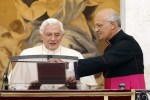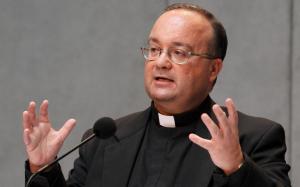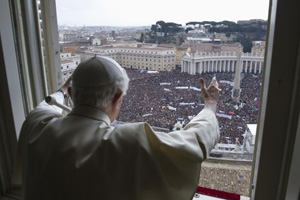On the 11th February 2013, soon after Pope Benedict XVI celebrated the mass commemorating the 900th anniversary from the foundation of the Sovereign Military Hospitalier Order of Saint John of Jerusalem of Rhodes and of Malta, also known as Order of Malta, he announced his resignation. The first Pope ever in the Church’s history to resign on voluntary basis, so we’re told.
We don’t think this is a coincidence. During the commemorative ceremony Pope Benedict XVI said the following:
“This important event takes on a special meaning in the context of the Year of the Faith, during which the Church is called to renew the joy and the commitment of belief in Jesus Christ, the one Saviour of the world. In this regard, you too are called to welcome this time of grace, so as to deepen your knowledge of the Lord and to cause the truth and beauty of the faith to shine forth, through the witness of your lives and your service, in this present time.”
The role of the Knights of Malta was (and still is) to defend Christianity and the Christians. In 1530, seven years after losing their base in Rhodes and moving from place to another in Europe, the Knights set foot on Malta when Charles V of Spain, as King of Sicily, gave them the Maltese Islands.
In 1565, the Ottoman Sultan, Suleiman the Magnificent, sent an invasion force of about 40,000 men to besiege the 700 knights and 8,000 Maltese and expel them from Malta and gain a new base from which to possibly launch another assault on Europe. The French scholar Voltaire, describing the 1565 Siege on Malta said, “Nothing is better known than the siege of Malta,” and it undoubtedly contributed to the eventual erosion of the European perception of Ottoman invincibility and marked a new phase in Spanish domination of the Mediterranean. The siege was the climax of an escalating contest between a Christian alliance and the Ottoman Empire for control of the Mediterranean. This siege was also prophesied by Nostradamus which took place during his lifetime.
To this day Malta still stands as the rocca forte of the Catholic church. Malta has a population that is strongly tied to the Roman Catholic Church. In fact the Constitution of Malta establishes Catholicism as the state religion. Catholicism is also present in various elements of Maltese culture. No wonder that in the last 25 years, Malta, one of the world’s smallest nations with just over 400,000 inhabitants, has been visited three times by a Pope (twice by Pope John Paul II and once by Pope Benedict XVI).
Malta’s main patron saint is St Paul, who allegedly got shipwrecked in Malta in 60AD and converted the Maltese to Christianity. The feast of the Assumption of Mary (15th August) is also widely celebrated also due to the fact that on the same day in 1942 a relief convoy as part of Operation Pedestal made it through the Axis’ blockade during the Second World War. This is commonly known as the Santa Maria Convoy. Fortress Malta, as it was known, was about to surrender. Had this happened, the Axis would have taken control of the entire Mediterranean and today Europe and the rest the rest of the world might be living another reality.
However the connection doesn’t stop there. Since Pope Benedict XVI announced his resignation, two Maltese clergymen got highly ranked posts in the vatican close to the Pontiff.
On the 22nd February 2013, Mgr. Antoine Camilleri, was appointed by Pope Benedict XVI to the third highest ranking post in the Vatican, making him under-secretary to the Holy-See’s relations with States. He replaces Mgr. Ettore Balestrero, who has been controversially appointed as Nuncio to Colombia, following reports about his close relations with Secretary of State Tarcisio Bertone, and his liaisons with the beleaguered Vatican bank IOR. Balestrero’s replacement and appointment as Nuncio to Colombia is being considered as a kick-upstairs in a bid to keep him away from Rome.
On the 18th March 2013, Mgr. Alfred Xuereb born in Victoria, Malta in 1958, became Honorary Prelate of the Roman Catholic Church, and first private secretary of Pope Francis I. Before being selected, he had served, next to the private secretary Georg Gänswein, as second private secretary of Pope Benedict XVI.
However the most important Maltese clergyman in the last decade has surely been Mgr Charles Jude Scicluna, the Vatican’s top prosecutor on child sex abuse cases. Scicluna became promoter of justice at the Congregation for the Doctrine of the Faith in 2002 to handle accusations of clerical sex abuse, after the doctrinal congregation was given the authority in 2001 to take over such cases from local bishops for investigation.
In 2005, as one of his most trusted men, Cardinal Ratzinger (who later that year became Pope Benedict XVI) sent Scicluna to Mexico and New York to collect testimony against the founder of the Legionaries of Christ, Fr Marcial Maciel, amid allegations of abuse.
Scicluna took a tough stance against abusive priests, saying the church must respond to allegations in a very clear way, and not react with “inertia, a culture of silence or repression.”
He also said that greater transparency and the protection of children are integral to the good of the universal church, and called for greater accountability under church law of bishops who shield or fail to discipline abusive priests.
The Archdiocese of Malta set up a sex-abuse “Response Team” in 1999. By 2010, the team had received accusations against 45 priests in connection with more than 80 allegations of sexual abuse against minors. Malta, which is 98 percent Catholic, has a population of 410,000.
Several Maltese priests have faced criminal trials in civil courts after victims, reportedly dissatisfied with the Response Team’s handling of their cases, chose to go to the police.
Some victims have accused the local church of delaying its own internal investigations pending the outcome of the criminal court cases.
Many believe Mgr Scicluna was sent to Malta to help with the situation and save possibly the last stronghold of the catholic faith.
For the first time, Pope Benedict XVI met with victims of abuse during a trip to Malta in 2010 and assured them that the church would do everything in its power to investigate allegations, punish those responsible and implement effective measures to protect children.
On the 6th October 2012 Pope Benedict XVI named him Auxiliary Bishop of the Archdiocese of Malta and at the same time Titular Bishop of San Leone. In an interview on the eve of his departure from Rome, Scicluna insisted he wasn’t the latest casualty in the Vatican’s turf battles and Machiavellian personnel intrigues. Rather, he said, his promotion to auxiliary bishop in his native Malta was simply that — “a very good” promotion — and more critically, that his hardline stance against sex abuse would remain, because it is Benedict’s stance as well. “This is policy,” he told The Associated Press. “It’s not Scicluna. It’s the pope. And this will remain.” He added, “If you want to silence someone, you don’t make him a bishop.”
He was conscrated bishop on the 24th November 2012. On the 1st December 2012 Bishop Scicluna was appointed a member of the Congregation for the Doctrine of the Faith for a five year renewable term by Pope Benedict.
With such an apostolic career behind him, could it be that Bishop Scicluna would be called again to Rome, this time to fill the post of Secretary of State of the Vatican?






